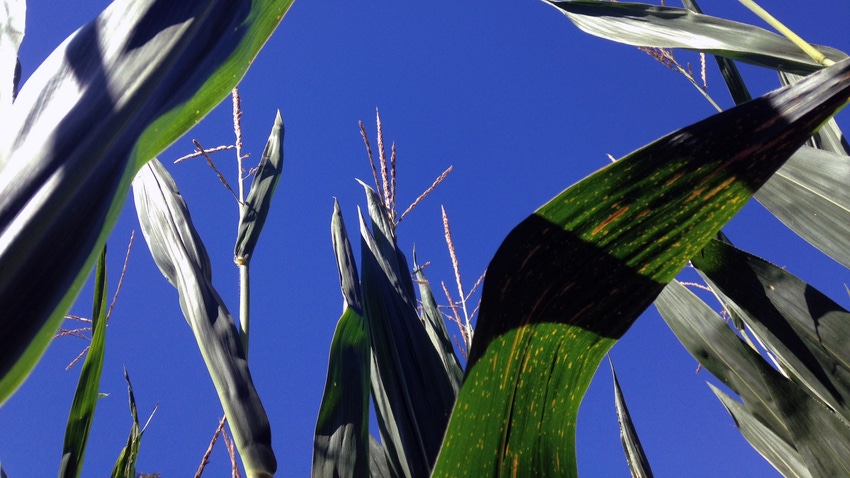
Midseason is an important time to protect a crop from disease, and it is even more critical this year when many growers have experienced extended periods of rain and overcast skies. Falling behind in disease control in the middle of the season will be difficult or impossible to overcome.
Stormy weather is highly favorable for the development and spread of disease. It can also delay fungicide applications and promote rapid plant growth, which leaves significant amounts of young, vulnerable tissue unprotected.
Corn
Southern corn rust has been found in several states to date and this disease can be both yield-limiting and explosive. Though severe outbreaks have been slow to develop in 2017, I still feel that corn growers should consider options to their crop between tassel and hard-dough stages. Triazole fungicides are often less expensive; products with multiple modes of action have greater efficacy, longer protective windows and often produce better yields.
Soybean
Soybean rust is present now in some kudzu patches across the Southeast and recent and current rains have been very favorable for rapid spread from kudzu to soybeans. As a part of our sentinel plot program supported by the Georgia Soybean Commission, kudzu sampled in Brooks County 10 days ago was found free of rust. This week we found that 35 percent of the leaf sample was infected with rust. I encourage soybean producers, especially those closest to the gulf, to consider fungicide treatments during late bloom and early pod fill stages.
Peanut
As of June 26 much of our peanut crop was less than 60 days old, but our disease diagnostic clinic in Tifton was already receiving samples of young plants affected by white mold. Abundance of soil moisture and now very warm temperatures will certainly fuel outbreaks of this potentially devastating disease; the extended period of rainfall will also enable significant outbreaks of leaf spot diseases as well. Peanut growers in the Southeast should be aggressive with their disease management program. This is especially important where disease-susceptible varieties are planted, in fields where rotation away from a peanut crop is difficult, and where rains have delayed timely fungicide applications. Saving money on less expensive products is always and attractive option. But bypassing the best products to save in expense may not be the most profitable decision in 2017.
Cotton
Bacterial blight has been found in Georgia’s cotton already this season. True, thus far it is limited to a single variety, but our weather had been quite conducive for this disease. Unfortunately, there is little or nothing that can be done when bacterial blight hits a field of cotton. These same weather patterns may also lead to the rapid development of another foliar disease of cotton called target spot. Target spot can cause rapid, premature defoliation of the cotton crop and may be associated with premature boll loss as well. Target spot is caused by a fungal pathogen and timely fungicide applications can protect not only the plant, but yield as well. I encourage growers to consider their situation in the cotton fields to determine if a fungicide treatment is merited. I believe that protecting the cotton crop between the first and sixth weeks of bloom can be of great value.
To spray or not?
Relating to the woes of midseason disease decisions, I’m reminded of a trip to the UGA Stripling Irrigation Park in late June, where BJ Washington and I carefully pushed our way through the dripping corn field, dodging rain showers in order to scout for any signs and symptoms of disease. We didn’t find any; the crop was beautiful and the yield promising.
“Which fungicide did you spray?” I asked BJ, expecting it had to have been one of the best ones.
“We didn’t spray a fungicide this year,” he grinned, knowing full well that such a decision ran counter to an earnest recommendation I had made to our corn growers. “In fact, we didn’t spray last year either.”
This wasn’t the first time I had heard such a comment in reference to disease protection on one of our row crops. More often than not, I hear it from a farmer who did apply the timely fungicide application recommended to him by Extension only to find that his neighbor, who ignored the advice and the expense of the treatment, did as well or better at harvest. It doesn’t happen often, but it stings and burns every time it does.
“I guess my neighbor just got lucky,” is a typical parting comment before we change the subject and move on. There is no guarantee that protecting your crop with a fungicide will result in increased yields or that you will realize less disease than if you hadn’t sprayed. Your neighbor, who saved the cost of a spray, or two or three sprays, might be lucky, but who in farming is willing to bank on “luck” when losses to disease or nematodes can amount to thousands of pounds, hundreds of bales or tens of bushels?
Scouting the corn fields at the Irrigation Park near Camilla, Ga., clearly showed that fungicides aren’t always needed to protect a crop and get strong yields. However, they are an important “insurance policy,” and is an insurance policy that can save a crop from disaster when needed.
Now is a critical time in the 2017 field season to make the right management decisions; missing the opportunity to protect the crop now may not be overcome later. The image of BJ’s grin as we walked his corn still lingers in my memory. You can bet I’ll walk it with him next year, and I’ll bet he can’t get lucky three years in a row.
About the Author(s)
You May Also Like






